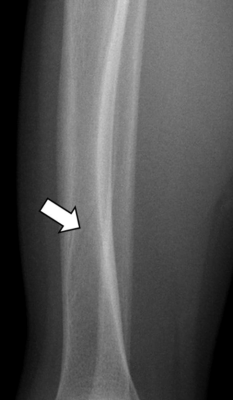A mother and father bring their 2-year-old boy to the Emergency Department after the child tripped over the family dog while running across the living room after a ball. He will not walk and points at his right lower leg and says it hurts (photo credit).
For more cases like these, you can check out the SplintER series archive or subscribe to the Ortho EM Pearls email series hosted by Drs. Will Denq, Tabitha Ford, and Megan French, who have kindly shared some of their content with ALiEM.
References
- Halsey MF, Finzel KC, Carrion WV, Haralabatos SS, Gruber MA, Meinhard BP. Toddler’s fracture: presumptive diagnosis and treatment. J Pediatr Orthop. 2001;21(2):152–6. PMID: 11242240
- Sapru K, Cooper JG. Management of the toddler’s fracture with and without initial radiological evidence. Eur J Emerg Med. 2014;21(6):451–4. PMID: 24802106
- Lewis D, Logan P. Sonographic diagnosis of toddler’s fracture in the emergency department. J Clin Ultrasound. 2006;34(4):190–4. PMID: 16615049
- Shravat BP, Harrop SN, Kane TP. Toddler’s fracture. J Accid Emerg Med. 1996;13(1):59–61. PMID: 8821231
- Tenenbein M, Reed MH, Black GB. The toddler’s fracture revisited. Am J Emerg Med. 1990;8(3):208–11. PMID: 2331262
- Seguin J, Brody D, Li P. Nationwide survey on current management strategies of toddler’s fractures. CJEM. 2018;20(5):739-45. PMID: 28743319
- Bauer JM, Lovejoy SA. Toddler’s fractures: time to weight-bear with regard to immobilization type and radiographic monitoring. J Pediatr Orthop. 2017. Epub ahead of print. PMID: 28141694
- Houlden R. Does immobilisation improve outcomes in children with a toddler’s fracture? Arch Dis Child. 2019;104(2):193-95. PMID: 30297443
- Schuh AM, Whitlock KB, Klein EJ. Management of toddler’s fractures in the pediatric emergency department. Pediatr Emerg Care. 2016;32(7):452–4. PMID: 26087443
- Adamich JS, Camp MW. Do toddler’s fractures of the tibia require evaluation and management by an orthopaedic surgeon routinely? Eur J Emerg Med. 2018;25(6):423-428. PMID: 28628487
- Mellick LB, Reesor K. Spiral tibial fractures of children: a commonly accidental spiral long bone fracture. Am J Emerg Med. 1990;8(3):234–7.PMID: 2331264
Author information
The post SplintER Series: A Toddler’s Missed Step appeared first on ALiEM.


 This is a radiographically subtle nondisplaced spiral fracture of the tibia in a child less than 3 years of age, also known as a toddler’s fracture or childhood accidental spiral tibia (CAST) fracture.
This is a radiographically subtle nondisplaced spiral fracture of the tibia in a child less than 3 years of age, also known as a toddler’s fracture or childhood accidental spiral tibia (CAST) fracture.